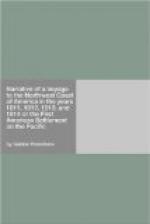The wind soon changed again to the S.S.W., and blew a gale. We had to beat. We passed in sight of the islands of Diego Ramirez, and saw a large schooner under their lee. The distance that we had run from New York, was about 9,165 miles. We had frightful weather till the 24th, when we found ourselves in 58 deg. 16’ of south latitude. Although it was the height of summer in that hemisphere, and the days as long as they are at Quebec on the 21st of June (we could read on deck at midnight without artificial light), the cold was nevertheless very great and the air very humid: the mercury for several days was but fourteen degrees above freezing point, by Fahrenheit’s thermometer. If such is the temperature in these latitudes at the end of December, corresponding to our June, what must it be in the shortest days of the year, and where can the Patagonians then take refuge, and the inhabitants of the islands so improperly named the Land of Fire!
The wind, which till the 24th had been contrary, hauled round to the south, and we ran westward. The next day being Christmas, we had the satisfaction to learn by our noon-day observation that we had weathered the cape, and were, consequently, now in the Pacific ocean. Up to that date we had but one man attacked with scurvy, a malady to which those who make long voyages are subject, and which is occasioned by the constant use of salt provisions, by the humidity of the vessel, and the inaction.
From the 25th of December till the 1st of January, we were favored with a fair wind and ran eighteen degrees to the north in that short space of time. Though cold yet, the weather was nevertheless very agreeable. On the 17th, in latitude 10 deg. S., and longitude 110 deg. 50’ W., we took several bonitas, an excellent fish. We passed the equator on the 23d, in 128 deg. 14’ of west longitude. A great many porpoises came round the vessel. On the 25th arose a tempest which lasted till the 28th. The wind then shifted to the E.S.E. and carried us two hundred and twenty-four miles on our course in twenty-four hours. Then we had several days of contrary winds; on the 8th of February it hauled to the S.E., and on the 11th we saw the peak of a mountain covered with snow, which the first mate, who was familiar with these seas, told me was the summit of Mona-Roah, a high mountain on the island of Ohehy, one of those which the circumnavigator Cook named the Sandwich Isles, and where he met his death in 1779. We headed to the land all day, and although we made eight or nine knots an hour, it was not till evening that we were near enough to distinguish the huts of the islanders: which is sufficient to prove the prodigious elevation of Mona Roah above the level of the sea.
CHAPTER IV.
Accident.—View
of the Coast.—Attempted Visit of the
Natives.—Their
Industry.—Bay of Karaka-koua.—Landing
on the
Island.—John
Young, Governor of Owahee.




